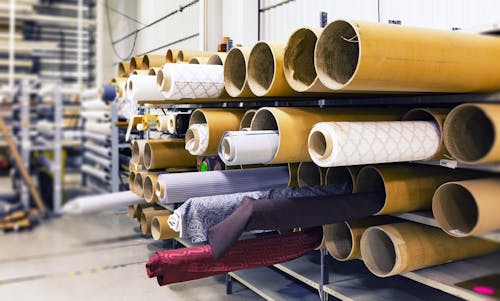
In recent years, the fashion industry has seen a significant shift towards sustainability, driven by growing environmental concerns and consumer demand for eco-friendly practices. Central to this transformation is the use of sustainable fabrics, which offer a promising alternative to traditional materials. This article explores the world of sustainable fabrics, their benefits, the innovations driving their development, and the impact they are making on the future of fashion. Introduction to Sustainable Fabrics
Sustainable fabrics are textiles made from materials that have a reduced impact on the environment compared to conventional fabrics. They are designed to be eco-friendly throughout their lifecycle, from production to disposal. This shift towards sustainability reflects a broader trend within the fashion industry to address environmental issues and promote ethical practices.
The Need for Sustainable Fabrics
The fashion industry is one of the largest polluters globally, contributing significantly to waste, water usage, and carbon emissions. Traditional fabrics, such as polyester and cotton, often involve:
- High Water Consumption: Cotton farming requires extensive water resources, leading to depletion of water supplies in some regions.
- Chemical Use: Conventional fabric production involves harmful chemicals that can pollute water sources and affect ecosystems.
- Waste Generation: Fast fashion contributes to enormous amounts of textile waste, with many garments ending up in landfills.
Sustainable fabrics aim to mitigate these issues by offering alternatives that are less harmful to the environment and promote responsible consumption.
What Defines a Sustainable Fabric?
A fabric can be considered sustainable if it meets certain criteria:
- Eco-friendly Sourcing: Materials are sourced from renewable or recyclable resources.
- Reduced Environmental Impact: Production processes minimize energy and water use and avoid harmful chemicals.
- Durability and Longevity: Fabrics are designed to be durable, reducing the need for frequent replacements and minimizing waste.
- End-of-Life Considerations: Fabrics are designed with recycling or biodegradability in mind to reduce landfill waste.
Types of Sustainable Fabrics
Sustainable fabrics come in various types, each with its unique benefits and applications. Here’s a look at some of the most notable sustainable materials:
Organic Cotton
Description: Organic cotton is grown without synthetic pesticides, herbicides, or genetically modified organisms (GMOs). It focuses on maintaining soil health and reducing environmental impact.
Benefits:
- Reduced Chemical Use: Organic farming practices avoid harmful chemicals, promoting healthier ecosystems.
- Water Conservation: Organic cotton farming often uses rainwater or more efficient irrigation methods, reducing water consumption.
- Soil Health: Practices such as crop rotation and composting improve soil fertility and prevent erosion.
Applications: Organic cotton is used in a wide range of products, including casual wear, undergarments, and home textiles.
Tencel (Lyocell)
Description: Tencel, also known as Lyocell, is made from sustainably sourced wood pulp, primarily from eucalyptus trees. It is produced using a closed-loop process that recycles water and solvents.
Benefits:
- Low Environmental Impact: The production process is more eco-friendly compared to traditional textiles.
- Biodegradability: Tencel is fully biodegradable, reducing its impact on landfills.
- Softness and Breathability: It is known for its softness, moisture-wicking properties, and breathability.
Applications: Tencel is commonly used in activewear, casual clothing, and bedding.
Hemp
Description: Hemp is a highly durable fiber derived from the hemp plant. It requires minimal water and pesticides, making it an environmentally friendly option.
Benefits:
- Low Water Usage: Hemp requires significantly less water compared to conventional crops like cotton.
- Soil Enrichment: Hemp cultivation can improve soil health and prevent erosion.
- Durability: Hemp fibers are strong and durable, contributing to long-lasting garments.
Applications: Hemp is used in a variety of products, including jeans, jackets, and eco-friendly accessories.
Recycled Polyester
Description: Recycled polyester is made from post-consumer plastic bottles or other polyester garments. It helps divert plastic waste from landfills and reduces the need for virgin polyester.
Benefits:
- Waste Reduction: Utilizing recycled materials helps reduce plastic waste and lower carbon emissions.
- Energy Efficiency: Producing recycled polyester often requires less energy compared to virgin polyester.
- Versatility: It retains many of the desirable properties of conventional polyester, such as durability and moisture-wicking.
Applications: Recycled polyester is used in a wide range of garments, including athletic wear, outerwear, and accessories.
Bamboo
Description: Bamboo fabric is made from the pulp of bamboo plants. It is known for its softness and natural antibacterial properties.
Benefits:
- Rapid Growth: Bamboo grows quickly and does not require pesticides, making it a sustainable resource.
- Natural Properties: Bamboo has natural antibacterial and moisture-wicking qualities.
- Biodegradability: Bamboo fabric is biodegradable, reducing its environmental footprint.
Applications: Bamboo fabric is used in clothing, bedding, and towels.
Innovations in Sustainable Fabrics
The field of sustainable fashion is continuously evolving, with new innovations driving the development of more eco-friendly materials. Some notable advancements include:
Bio-fabrication
Description: Bio-fabrication involves creating fabrics from biological materials, such as fungi, algae, or bacteria. These processes aim to produce textiles with minimal environmental impact.
Examples:
- Mycelium Leather: Made from the root system of fungi, offering a sustainable alternative to animal leather.
- Algae Fabrics: Produced from algae, these fabrics are biodegradable and have a low environmental impact.
Circular Fashion
Description: Circular fashion focuses on creating closed-loop systems where materials are continually recycled or repurposed. This approach minimizes waste and maximizes resource efficiency.
Examples:
- Closed-Loop Recycling: Fabrics made from recycled materials that can be recycled again at the end of their lifecycle.
- Design for Disassembly: Garments designed to be easily taken apart and recycled into new products.
Advanced Dyeing Technologies
Description: Innovative dyeing technologies aim to reduce water usage and chemical pollution in the dyeing process.
Examples:
- Waterless Dyeing: Techniques such as CO2 dyeing eliminate the need for water in the dyeing process.
- Natural Dyes: Using dyes derived from plants and other natural sources to reduce the environmental impact of synthetic dyes.
The Impact of Sustainable Fabrics on the Fashion Industry
Sustainable fabrics are making a significant impact on the fashion industry in several ways:
Changing Consumer Preferences
Consumers are increasingly prioritizing sustainability in their purchasing decisions. This shift is driving brands to adopt more eco-friendly practices and incorporate sustainable fabrics into their collections.
Influencing Fashion Trends
Sustainable fabrics are becoming integral to fashion trends, with designers and brands showcasing their commitment to eco-friendly practices. This has led to increased visibility and acceptance of sustainable fashion.
Promoting Industry Collaboration
The push for sustainability is encouraging collaboration across the fashion industry, including partnerships between brands, fabric manufacturers, and technology innovators. This collective effort is accelerating the development and adoption of sustainable practices.
Addressing Environmental Challenges
The use of sustainable fabrics helps address key environmental challenges associated with traditional fashion practices, including reducing waste, conserving water, and lowering carbon emissions.
Challenges and Future Prospects
While sustainable fabrics offer numerous benefits, there are still challenges to overcome:
Cost and Accessibility
Sustainable fabrics can be more expensive to produce compared to conventional materials. This cost can be a barrier for some consumers and brands. Efforts are being made to improve accessibility and affordability through technological advancements and economies of scale.
Scalability
Scaling up production of sustainable fabrics to meet global demand remains a challenge. Continued investment in research and development is crucial to increase production capabilities and ensure widespread availability.
Consumer Education
Educating consumers about the benefits of sustainable fabrics and encouraging informed purchasing decisions is essential for driving further adoption and support for eco-friendly fashion.
Industry Standards
Establishing clear standards and certifications for sustainable fabrics can help ensure that claims of sustainability are accurate and meaningful. This will contribute to greater transparency and accountability within the fashion industry.

Sustainable fabrics represent a crucial step towards a more eco-friendly and ethical fashion industry. By embracing materials that minimize environmental impact and promote responsible consumption, the fashion world can address pressing environmental issues and pave the way for a more sustainable future. As innovations continue to drive the development of new and improved sustainable fabrics, the potential for positive change within the industry is immense. Embracing these fabrics not only contributes to a healthier planet but also supports a more conscious and thoughtful approach to fashion. With ongoing efforts from consumers, brands, and industry stakeholders, sustainable fabrics will play a central role in shaping the future of fashion.









